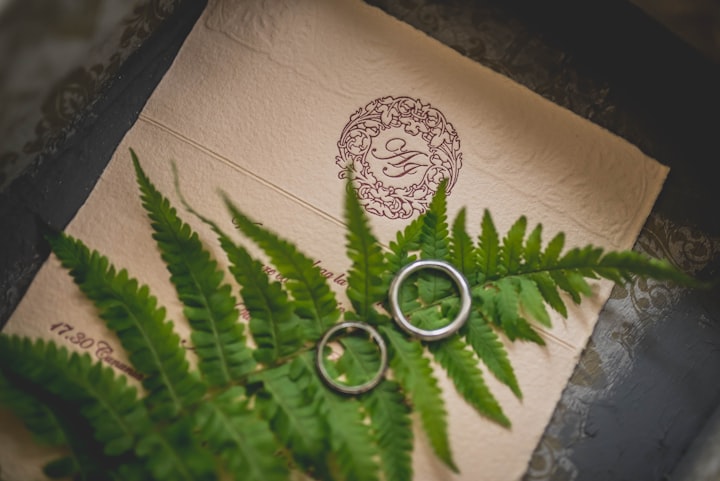The Nitty Gritty of Wedding Invitation Etiquette
No, you don't need an outer envelope

When I was hired as a stationer six years ago, I didn't even know what a stationer was. For the uninitiated, a stationer is the person you go to when you want personalized cards, letterhead, or invitations. And yes, in the digital age it is rapidly becoming a thing of the past.
But that's precisely what interested me.
As someone who likes learning about obscure things, I was more than excited by the prospect of gaining a unique skillset and learning all I could about the sometimes ridiculous, sometimes baffling rules of etiquette. And I certainly did learn a surprising thing or two about stationery, particularly the uniquely complex rules surrounding wedding invitations.
The business of getting married is expensive and going to a stationer may not be in the budget for a lot of couples these days. I know a lot of people who have elected to design their wedding invitations on their own and in many cases the results have been impressively beautiful and elegant. But I also know that planning a wedding is stressful and it can be difficult to know where to start when putting together the invitation.
Well, whether you're designing your invitation online or going through a classic stationery vendor, knowing the traditional etiquette can help you make decisions more confidently.
First of all, avoid abbreviations
Just about everything on a wedding invitation should be spelled out. Numerals are acceptable for the street address and zip code, but every other part of the address that is usually abbreviated should be spelled out. This includes the state, the direction (North, South, East, West), and the "type" of street (it's spelled Boulevard).
Example: 123 West Main Street, Los Angeles, California 90000
This rule also extends to the time and, in this case, numbers should also be spelled out.
Example: The twenty-fifth of December at four o'clock in the afternoon
About the time
Traditionally, wedding ceremonies start on the half hour and the reason is based entirely in superstition. It is believed that it is lucky to start a marriage on the half hour because the minute hand on the clock will be moving upward as the couple begins their new chapter. That being said, the time listed on the invitation is often a half hour early.
Come on, we all have that branch of the family tree that can never manage to be on time EVER, right? Most couples build in a margin of error by having their ceremony start half an hour after the time listed on the invitation. Therefore, if you're ceremony starts at 4:30, you may want to list the time on the invitation as 4:00.
Okay, so what about the wording?
Did you know that some of the wording on a wedding invitation depends on where the ceremony is held? At the top of the invitation, there is usually a line formally inviting the guest to the wedding, but there are a couple traditional variations on this line.
If you're getting married in a church, this line will read The honor of your presence is requested at the marriage of...
However, if your ceremony is being held anywhere other than a church, this line will read The pleasure of your company is requested at the marriage of...
That being said, you don't have to use either one of these lines. If you're having a themed wedding or simply want to customize your wording, go for it!
Truth is, some traditions are outdated
For some, tradition is everything. I've certainly done wedding invitation orders where the couple wants every aspect to be in line with tradition, and that's completely fair. But I'm here to tell you that some of those traditional aspects simply don't serve a purpose anymore.
You may be familiar with the concept of inner and outer envelopes. It's seen as a sign of refinement for a wedding invitation to come in a lined, inner envelope within another outer envelope. The truth? Back in the days of the Pony Express when it took a piece of mail weeks or even months to get from A to B, people often used two envelopes as an extra layer of protection. By the time a letter or an invitation got where it was going, the outer envelope was so dirty and damaged that it was simply discarded. These days, the Post Office doesn't rely on men on horseback so the outer envelope doesn't serve any purpose beyond being of symbol of traditional etiquette.
As for that layer of tissue paper that sometimes comes in invitations? In the past, ink didn't dry the way it does now. The tissue paper was there to prevent bleeding and smudges which isn't as much of a concern now. If you want my opinion, save your tissue paper money for something that will make your day more meaningful.
Speaking of ink...
There's a variety of options when it comes to printing your invitations, ranging from methods that use older technology to methods that are entirely modern.
Engraving, letter pressing, and blind embossing all require the printer to create a custom metal plate (in the case of engraving and blind embossing, they’ll even send you the plate as a keepsake!). Engraving is a raised printing method where the ink sits on top of the paper and if you run your fingertips over it, you will feel the raised lettering. Similar to engraving, blind embossing is a raised method, however, no ink is involved. This is typically used for detailing and not the wording itself. It raises the paper in either a motif or a monogram for a textured, but subtle look. Letter pressing, as the name suggests, is a method where the printing is pressed into the paper, creating a depressed texture. This method can only be used on certain types of paper because the stock must be thick enough to press and not tear.
Thermography mimics the look of engraving, but is a more cost effective alternative. With this method, the printing is raised, but does not require a plate. As the name suggests, thermography uses heat applied to a combination of ink and embossing powder. The end result will have a shinier look than engraving and, if you look closely, you’ll be able to see a slight texture to the lettering.
Foil stamping gives your invitation a classy look that mimics letter pressing, but uses colored foil instead of ink.
Digital printing is the most economical. In this method, the ink prints flat against the paper. Is it fancy? No. Does it get the job done? Absolutely.
Always request a proof!
Always, always, always. Some stationery vendors will offer the first proof complimentary, but even if you've chosen a vendor that does charge a small fee, it is worth it.
Wedding invitations are often detailed, high-volume orders and having to do a reprint is time-consuming and creates far more stress than you need.
***
There's so much information (and so many opinions!) on what is proper for a wedding, but at the end of the day, all that matters is that the invitation you send out reflects who you are. This is your day! As long as your invitation reaches those you care about most and is indicative of the type of wedding you want to have, that is far more important than tradition, no matter how many aunts may be telling you otherwise.
Let these traditions simply be guidelines that give you a place to start and hopefully it will make at least one aspect of your wedding planning a little less stressful.
About the Creator
Rebecca Johnson
Writer with a lot of different interests from dog rescue to medieval history to haunted houses to welding
Mental health matters
Follow me on Twitter @AliasRebecca






Comments
There are no comments for this story
Be the first to respond and start the conversation.